Gaura flowers (Gaura lindheimeri), also known as Lindheimer’s bee blossom, white gaura, and wand flower is a charming flowering plant that will add lots of texture and color to your garden bed.
This delicate plant produces vivid white flowers or pink buds on tall spikes. These flower spikes give the flowers an airy appearance that reminds many people of butterflies.
These herbaceous perennials are frequently used in xeriscaping projects, rocky gardens, and other ornamental gardens because they are easy to grow, easy to care for, and can add lots of garden merit.
Bee blossom can look attractive if it is mass planted and it can also be paired with other plants to enhance the appearance of this flower bush.
In this guide, we are going to take a quick look at some of the best gaura companion plants to include in a mixed garden bed.
What to Plant with Gaura (Gaura lindheimeri)
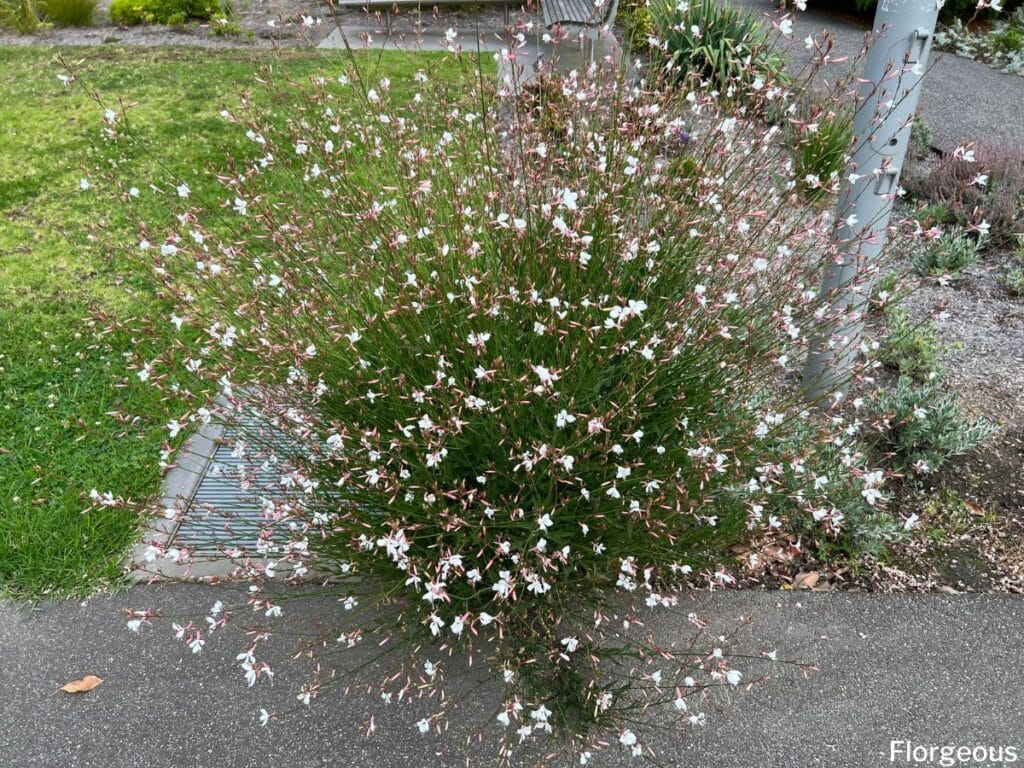
When you are looking for the best companion plants for your garden, it is always best to focus on varieties that have similar growing needs. When all the plants in your garden have the same growing conditions, it will greatly reduce your maintenance.
Gaura lindheimeri is one of the easiest plants you can grow. With its attractive pink flowers, it thrives in just about any setting as long as the soil is well-draining.
Beeblossom is a type of wildflower that can grow in just about any type of soil that drains well. It will even grow well in clay soil types as long as there is proper drainage.
The Gaura lindheimeri plant also requires direct sunlight and it is drought tolerant which means it can get by with minimal watering. You can check our blog to learn more about gaura plant care.
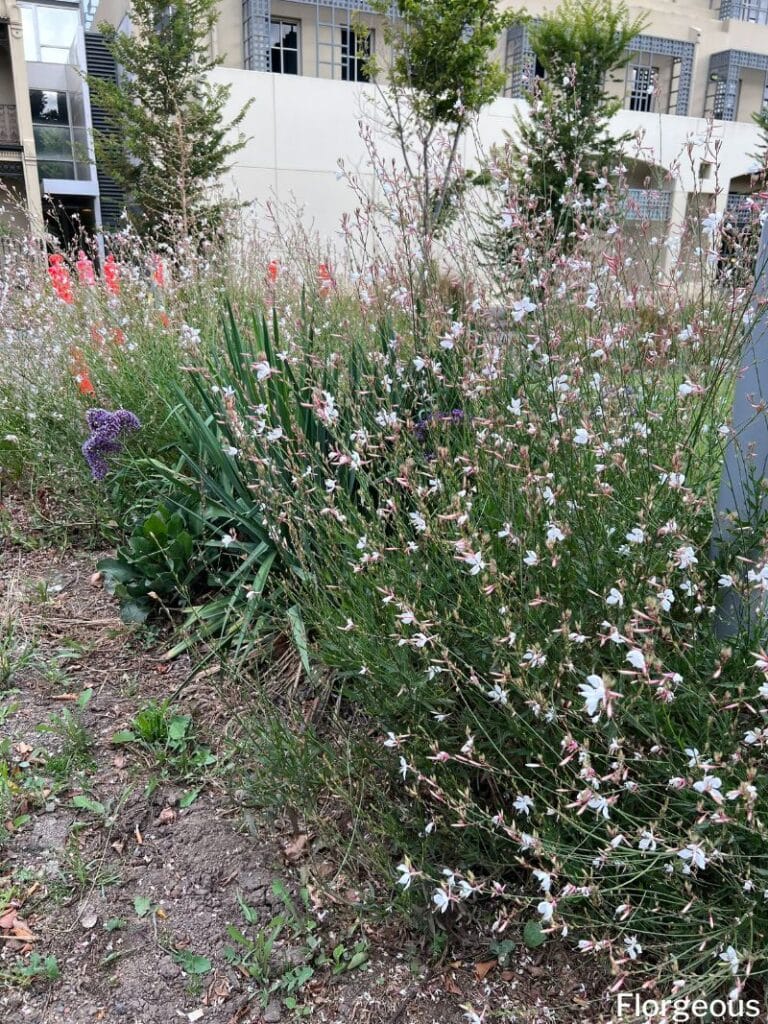
Let’s explore some of the best plant varieties to pair with these bright pink gaura flowers if you want to create a striking and easy-going garden.
Sage
Sage (Salvia officinalis) is one of the very best whirling butterfly companions because its blue-tinted foliage will add lots of contrast next to the dark green leaves of the deep pink flowers of the gaura plant.
As with bee-blossoms, sage also blooms in summer and will add lots of interest with its beautiful purple flower spikes. These stand out sharply against the stark white flowers of Gaura lindheimeri.
You can pair just about any sage variety including Mexican Bush Sage (Salvia leucantha), Meadow sage (Salvia sylvestris), Russian sage (Salvia Yangii), Cleveland sage (Salvia clevelandii), or ‘Nana’Autumn sage (Salvia greggii) with your bee blossoms because any of these varieties will grow well with gaura plants and will look fantastic in your garden bed.
Sage is a great companion plant because it thrives in direct sun and well-draining soil and it is also drought tolerant so you can cut back on water usage and still get a beautiful garden.
See more: Russian sage little spire companion plants
Lavender
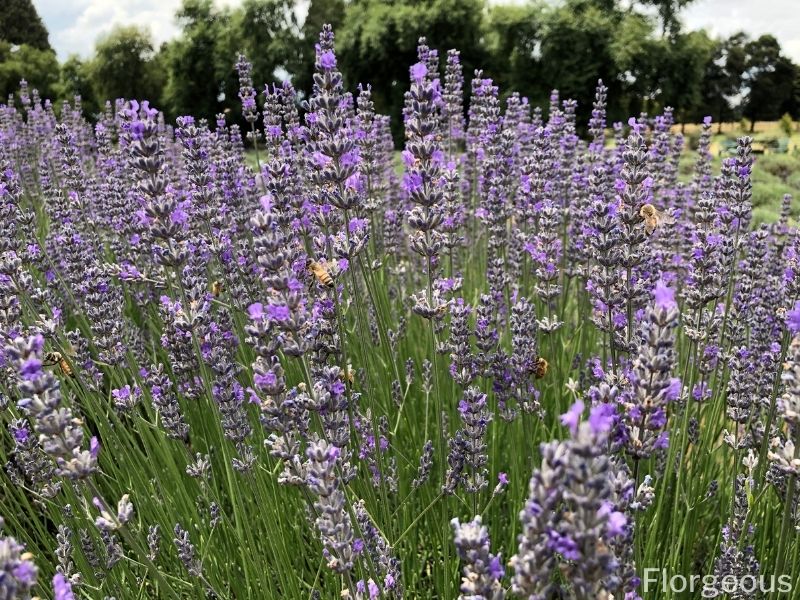
Lavender (Lavandula) is also terrific for companion planting in dry areas and we especially recommend the Lavandula intermedia var. cultivar because this one is especially fragrant.
Lavender produces lots of small purple flowers on spikes when it blooms during summer. This vivid display of purple will look charming when you add white gaura (Oenothera lindheimeri), or even pink gaura (Siskiyou pink) to your garden bed.
Lavender should be planted in full sun or it will not produce flowers. This plant also needs well-drained soil and it requires minimal watering.
During extremely hot seasons, you can give these fragrant flowers a little bit more water. The delicate white flowers of your Gaura lindheimeri will appreciate the extra drink, too!
Because lavender and bee blossom have similar growing heights, you can mix these plants all over your rocky garden. It is, however, important to leave plenty of room between these plants because lavender does need plenty of air circulation.
Lavender looks beautiful with just about any kind of gaura plant, but especially “Crimson Butterflies.”
See more: What pairs well with lavender plants
Purple Coneflower
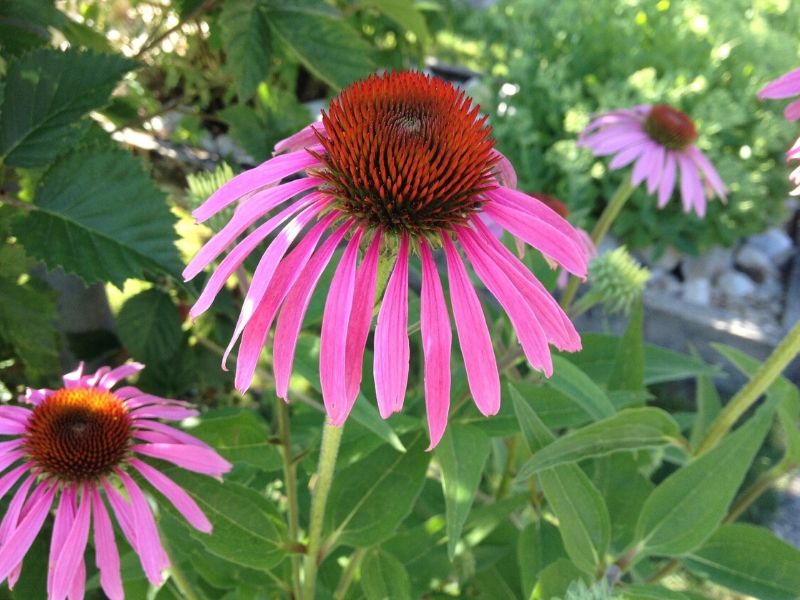
Purple coneflower (Echinacea purpurea) is another great companion to consider if you want to add even more blooms to an already pinkish garden. This edible plant will produce lots of large, bright pink flowers that can enhance the aesthetics of your garden bed.
Coneflowers thrive in direct sun and these perennials will take well to any type of well-draining soil. They require minimal watering and, aside from occasional deadheading, they require very little maintenance.
These vibrant flowers are rather tall with a maximum height of 4 feet tall. It is best to establish your taller echinacea flowers behind the shorter and more delicate wandflowers.
Purpletop Vervain
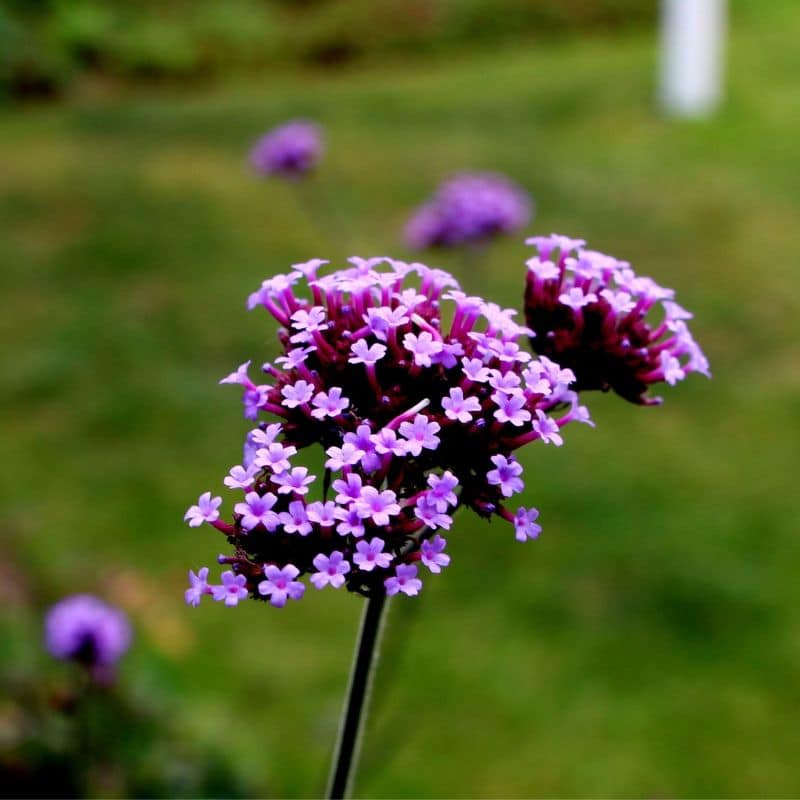
Purpletop vervain (verbena bonariensis), also known as cluster-top vervain, Argentinian vervain, or pretty verbena, is another great cultivar to add if you want to form a passionate rainbow of color to your garden.
This plant produces tiny flowers in clusters on tall stems. These small flowers will compliment the gaura very nicely because they are also delicate in texture.
Purpletop vervain should be grown in full sun but it can also survive in partial shade. They need to be established in well-draining soil and they do need a little bit more water compared to the drought-tolerant gaura.
To grow these two flowering plants together, it is best to establish the taller purple tops behind the gaura plants. It can also be good if you grow gaura in an area where they might get a little bit more shade.
Wormwood
Wormwood (Artemisia schmidtiana ‘Silver Mound’), is a good option if you are looking for an ornamental shrub to fill out your garden bed, add lots of texture, and protect your gaura plants.
This aromatic plant is known to repel certain insect pests like fleas, flies, and ground larvae because it has an unpleasant smell and a very bitter taste.
The shrub grows well in poor soil, and rocky slopes and it requires minimal watering. Wormwood also prefers sunny locations with well-draining soil. It looks particularly attractive next to Siskiyou pink gaura plants.
Because this bushy plant can get rather tall with a maximum height of 1.2 meters, it is usually best to position it at the back. As a vivid green backdrop, the dark pink flowers of your gaura will stand out so much more.
Karl Foerster Grass
Decorative grass plants like Karl Foerster grass (Calamagrotis acutiflora) are very common in rocky gardens and xeriscape landscapes because they can add vertical appeal. These ornamental grasses will also look rather striking alongside gaura plants.
Karl Foerster grass grows very well in full sun but needs rich, well-draining soil. The grassy plant is extremely hardy and only needs to be watered about once a month.
Because this grass variety typically reaches a height of 2 – 3 feet tall, it is usually best to establish it behind the gaura plants. Alternatively, you can also add it in clumps all over a rocky scape.
See more: What to plant with Karl Foerster grass
What NOT to Plant with Gaura

Not all plant species will grow well in the same hardy area that gaura plants can survive in. There are quite a few plant species that will never take to these harsh environments and some aren’t good companions because they might deprive the gauras of natural sun.
Here is a quick look at some plant varieties you should avoid next to gaura.
Shade Loving Plants
When looking for gaura whirling butterflies companion plants, avoid shade-loving plant varieties like hostas, ZZ plants, and ferns because they won’t grow well in a dry and sunny area. It is best to save these moisture-needy plants for some of the shady areas in your garden.
Tall Plants
You shouldn’t establish gaura underneath tall trees or next to tall plants. These taller species will block the sun which will affect the flower’s ability to produce lots of beautiful flowers. Wiry flower stems should be at the back, too.
Final Thoughts
Gaura plants can look wonderful if paired with plant species like lavender, coneflowers, sage, wormwood, ornamental grasses (ideally those with burgundy foliage or even blue foliage instead of the traditional green foliage) or purple-top vervain. We are certain that these plant combinations will help you create a striking garden that is bound to lure lots of butterflies to your garden.
If you are also adding other plants to your garden then you should look at some of our other guides. In these guides, we discuss different plant species and all the best plants you can pair with them for a beautiful garden.
See more:







